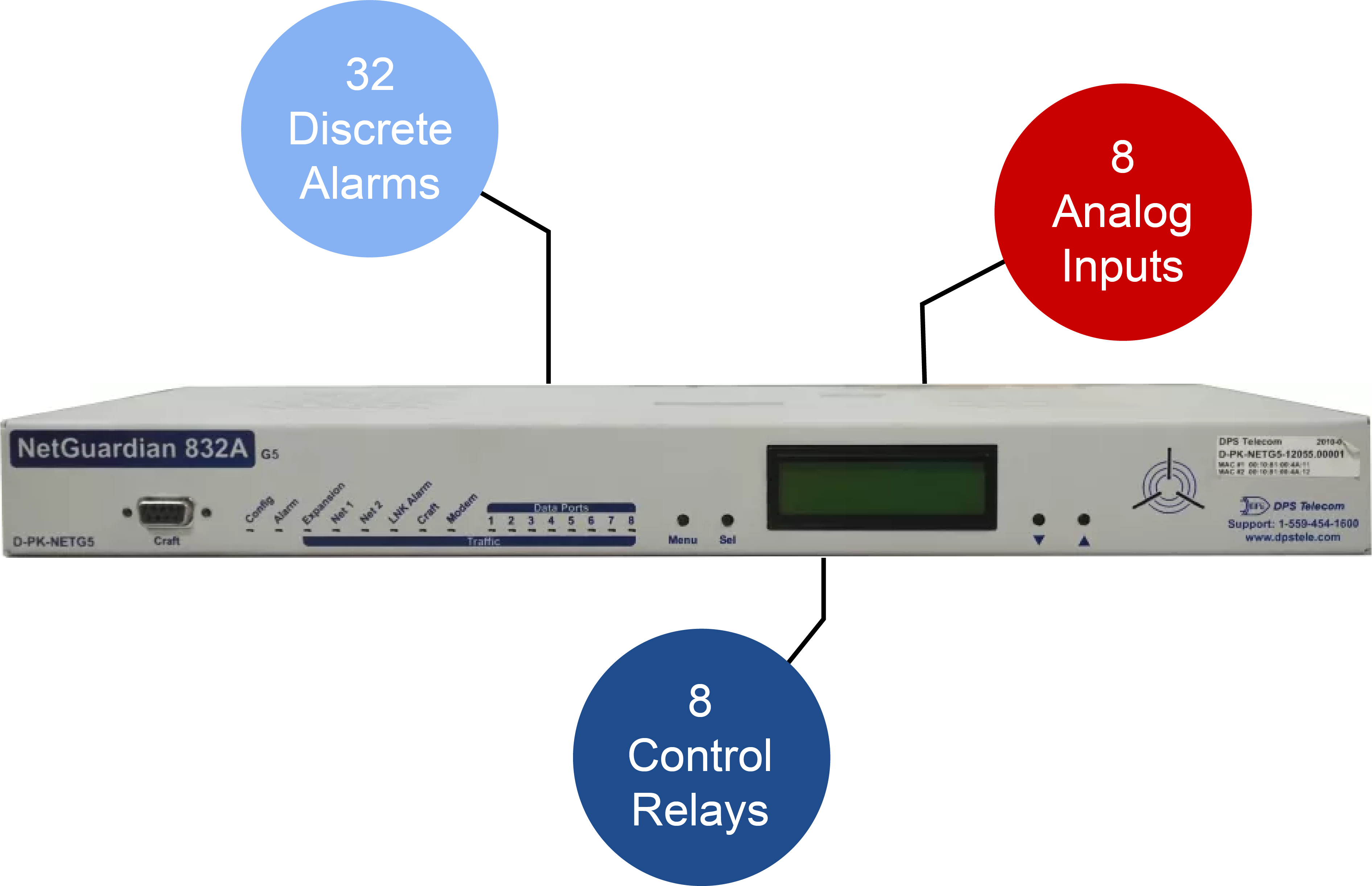Check out our White Paper Series!
A complete library of helpful advice and survival guides for every aspect of system monitoring and control.
1-800-693-0351
Have a specific question? Ask our team of expert engineers and get a specific answer!
Sign up for the next DPS Factory Training!

Whether you're new to our equipment or you've used it for years, DPS factory training is the best way to get more from your monitoring.
Reserve Your Seat TodayAt DPS Telecom, we understand the challenges faced by relying heavily on Remote Telemetry Units (RTUs) for monitoring and control. Recently, JP, a DPS engineer, chatted with a client looking for a replacement for their current RTUs.
As we look at this conversation, you will learn about several key considerations when upgrading RTUs and see examples of tailored solutions to meet specific needs.
Our client is in charge of a fleet of RTUs for a gas distribution company. Early in the conversation, they described their current challenges:
"Our current RTUs do flow calculation with AGA3, 7, and 8. They monitor various analog inputs, discrete inputs, and digital outputs for regulator pulse control for multiple gas systems. Some analog outputs are used for flow positioners."
JP summarized the client's needs effectively:
"To summarize, you will need an RTU that accepts analog and discrete inputs, and you will also need digital and analog outputs."
This scenario is common across industries where legacy RTUs struggle to keep up with modern requirements. The client further explained their additional requirements:
"Our current SCADA system uses BSAP but will be updated to accommodate DNP3. Some of the features I'm looking for are dual CPUs, better memory management. Currently, I have to power down the RTU, pull out the CPU, remove the battery, and install a new one. This wipes out the configuration. It has to be restored, and every signal verified, causing an extra 2-3 hours of time."

The client's frustration with their current system was evident. They had specific issues with both the inconvenient process of replacing the CPU and the risk of configuration loss due to power interruptions.
This not only wastes time but also increases the risk of errors during reconfiguration. JP offered a solution from DPS Telecom that addressed these issues:
"Our RTUs store configuration in non-volatile memory. Power loss does not impact the configuration, and a battery is not needed."
Non-volatile memory ensures that configurations remain intact even during power outages. This eliminates the loss of buffered alarms or logged sensor data during a power failure. JP further reassured the client:
"This feature can save you up to 3 hours of time on each unit in the long run."
This highlights the practical benefits of reducing maintenance time and ensuring continuous operation.
Imagine a scenario where upgrading your RTUs is seamless, configurations are never lost, and the system is tailored to your specific needs. You can achieve this with DPS Telecom's customizable solutions.
JP assured the client of the flexibility and customization capabilities of DPS Telecom:
"We currently do not have something off the shelf that has analog outputs. However, DPS Telecom is able to provide customized solutions. With the amount being purchased, we normally waive any non-recurring engineering costs associated with it. My next question would be the timeline you would be looking at for replacement. It usually takes about 90 days for our first custom units to be produced."

DPS Telecom's RTUs, such as the NetGuardian series, offer a range of benefits that address the client's needs:

One of the standout features of DPS Telecom's approach is their ability to customize solutions based on specific client needs. This capability was highlighted when JP addressed the client's unique requirements for additional RTUs at control points:
"We currently have approximately 80 RTUs and I'd like to add about 40 basic ones at control points. Essentially pressure readings at the end of some systems, so around 120 give or take a few. Do you have an overview with specifications you can send me?"
JP's response emphasized DPS Telecom's commitment to meeting these needs with custom-made solutions:
"We can always build from our existing product line to meet your exact specs. With your project timeline, we can ensure that the custom units are ready within the 90-day production window."
This approach ensures that clients receive exactly what they need, tailored to their specific operational requirements. It also underscores the readiness and responsiveness of DPS Telecom in handling complex client demands.
A major pain point for many organizations is the complexity involved in configuring and managing multiple RTUs. DPS Telecom offers solutions to streamline these processes, as JP explained:
"We also have a feature that can push configurations to our devices from a central location. This will significantly reduce the time and effort required for manual configuration and verification of each unit."
Centralized configuration management ensures that updates and changes can be deployed quickly and uniformly across all units. This reduces the risk of errors and enhances overall efficiency. This is particularly beneficial for large-scale deployments, such as the one described by the client, involving around 120 RTUs.
DPS Telecom's commitment to long-term support and partnership was a key point of discussion. The client expressed the need for a reliable solution that would remain in service for over a decade:
"I'm looking at a lot of options as these will possibly be in service for 10 plus years."
JP reinforced DPS Telecom's dedication to providing durable and reliable solutions:
"We have proven products that are currently in the field for over 10 years. Our solutions are built to last, ensuring that your investment is secure for the long term."
This assurance of longevity, backed by a history of reliable performance, provides clients with the confidence that their critical monitoring infrastructure will remain trustworthy and effective for years to come.
For your reference, here's the full chat text that we discussed here today:
JP: Hello! Let me know if there's anything I can help with.
Client: I am currently in charge of an RTU fleet for a gas distribution company. Looking for information on a replacement for our current model.
JP: I can help you with that. Can you tell me what your current RTUs are doing?
Client: They do flow calculations with AGA3, 7, and 8. They monitor various analog inputs, discrete inputs, and digital outputs for regulator pulse control for multiple gas systems. Some analog outputs are used for flow positioners, etc.
JP: To summarize, you will need an RTU that accepts analog and discrete inputs. You will also need digital and analog outputs.
Client: Yes. Our current SCADA system uses BSAP but will be updated to accommodate DNP3. Some of the features I'm looking for are dual CPUs, better memory management. I currently have to power down the RTU, pull out the CPU, remove the battery, and install a new one. This wipes out the configuration. It has to be restored and every signal verified. This can cause an extra 2-3 hours of time for reprogramming and verification.
JP: I am curious, why are you having to replace the CPU? Is it part of an upgrade? How many of these do you have to work on?
Client: It's not the CPU. The battery for memory management is located on the CPU. If there are any power interruptions and the battery is low on voltage after a couple of years, it will cause the configuration to be lost. I know some PLCs are capable of a battery swap while staying in service and was hoping that feature is in some new RTUs.
JP: Our RTUs store configuration in non-volatile memory. Power loss does not impact the configuration, and a battery is not needed.
Client: Even better.
JP: How many RTUs will you be considering for replacement?
Client: We currently have approximately 80 and I'd like to add about 40 basic ones at control points. Essentially pressure readings at the end of some systems, so around 120 give or take a few. Do you have an overview with specifications you can send me?
JP: We currently do not have something off the shelf that has analog outputs. However, DPS Telecom is able to provide customized solutions. With that amount being purchased, we normally waive any non-recurring engineering costs associated with it. My next question would be the timeline you are looking at for replacement. It usually takes about 90 days for our first custom units to be produced.
Client: We are in the beginning phase with a possible start next year, and the project would most likely take at least 2 years to be completed.
JP: That would be enough time to produce what you need. Are you and your team willing to engage in a meeting to discuss a customized solution? Based on the information you have provided so far, I can confirm that you will not lose any configuration due to loss of power. We also have a feature that can push configurations to our devices from a central location. These two features seem like they can save you up to 3 hours of time on each unit in the long run.
Client: Yes here is my work email.
JP: Okay, you work with a public service electric and gas company?
Client: Yes. If you can send me a product overview to see if your product can meet our criteria, then we can set up a meeting. I'm looking at a lot of options as these will possibly be in service for 10 plus years.
JP: Are you familiar with Camila Sierra, I believe she is in Telecom? We have proven products that are currently in the field for over 10 years.
JP: I can provide you a product overview. However, keep in mind that we have full ability to customize the product to meet your exact specs.
JP: For your solution, we will be leaning more towards a customized solution. The reason I ask if you know her is that they are looking at one of our products as well. One of the solutions they are considering would be implemented in your design. It is possible that you may have some cost savings advantages to your budget by bringing both on board.
Client: I'm not familiar with her. I understand the customization aspect. I like the fact that you may be able to provide us with something in that regard. We would probably stay away from any joint ventures like that, especially with all the cybersecurity and TSA directives we are facing.
JP: Understandable. I will send you a product overview of two of our products. This will give you an idea of what we provide off the shelf. We can always build from that.
Client: I will take a look at the overview and come up with a list of things we would need. Then perhaps we can get things off the floor if possible. Thank you for your time and I look forward to seeing the overview.
JP: Certainly. I have your email, so you can expect the overviews to arrive shortly.
If you're facing similar challenges with your current RTUs, it's time to consider an upgrade. DPS Telecom offers solutions that are not only reliable and efficient but also customized to your specific needs. Our expert engineers are ready to assist you in designing a system that ensures your critical operations are monitored accurately and reliably.
Contact DPS Telecom today at 1-800-622-3314 or email sales@dpstele.com to discuss your requirements and start the journey towards a more efficient and reliable monitoring system.

Andrew Erickson
Andrew Erickson is an Application Engineer at DPS Telecom, a manufacturer of semi-custom remote alarm monitoring systems based in Fresno, California. Andrew brings more than 18 years of experience building site monitoring solutions, developing intuitive user interfaces and documentation, and opt...